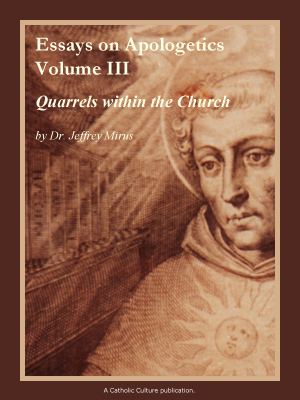Our Lady of Lujan
by Zsolt Aradi
Following the initial wave of religious enthusiasm that beset the conquistadors and early settlers in the southern part of the Western Hemisphere, many communities suffered relapses, particularly those which were isolated and thus felt more disheartened by the burden of their strenuous daily struggle. The city of Cordova, in the interior of Argentina, was particularly aware that the religious spirit of the city was slowly dying out. In 1630, a Portuguese settler decided that he would do something to change this distressing situation and he asked a friend to go to Brazil and to bring back with him a statue of the Blessed Virgin. The friend duly purchased two very simple statues, and his trip from Brazil to Buenos Aires was uneventful. But in the capital, before starting on his return trip inland, he made very elaborate preparations, because in those days, no traveler was safe from attacks by the Indians. He organized a whole caravan of covered wagons to protect himself. Argentina is still a land of vast dimensions, endless plains, romantic mountains, and blessedly fertile soil. Three hundred years ago, when great distances always meant endless long trips, every stopover on a journey was an event to remember.
The caravan was bound to reach Cordova as soon as possible. Providence, however, decided otherwise. The Portuguese settler who wanted to renew the religious life of his city appears to us from the perspective of three centuries, as a mere instrument of God, destined to perform something of a different nature through his pious determination. One statue reached its destination in due time, and did not become famous, while the other was never to reach Cordova; it was left behind at the first stopover, a ranch. There it was to give origin to one of the greatest sanctuaries in Latin America, Lujan.
Of two small statues purchased by the settler one represented the Mother of God with her Child, and the other, the Blessed Virgin of the Immaculate Conception. Both were simple, about twenty inches high, made of terra cotta. After leaving Buenos Aires the caravan traveled for one day when, near a ranch, the horses of one of the wagons stopped and despite every effort on the part of the driver, could not be budged from the spot. But the animals started off again as soon as the figure of the Immaculate Conception had been removed from the cart and carried into the ranch. The ranch owner entrusted it to the care of a Negro slave from Angola.
This humble man, by some inner compulsion, dedicated himself completely to the care of this statue. And apparently it was at his insistence that soon afterwards a little chapel was built for it. From this moment, miraculous events set in.
The statue disappeared from the chapel, though its doors were properly locked and guarded during the night. The statue was found at the very spot where the horses of the original caravan had stopped and refused to move any further! This transference was repeated several times. Ecclesiastical authorities finally decided that a new church should be built to enshrine the figure of the Immaculate Conception.
Lujan today is a great religious center, with many churches. Soon after the first church had been completed, it proved insufficient to provide for the pilgrims who came from all over the vast country. Many recorded miracles occurred, and various Kings of Spain (Argentina was then a colony of Spain) bestowed upon the shrine gifts and jewels as ornate as those donated to the oldest and most famous ones in Europe. Argentina has many other holy places dedicated to the Virgin, but Lujan is the most outstanding. Several religious orders, the Carmelites, the Dominicans, the Jesuits, the Franciscans and others have established churches and monasteries around the shrine, which now is in the custody of the Lazarists.
In 1904, the image was placed in the new cathedral, while it was still under construction. The cathedral was completed and consecrated in 1910. It is one of the most important in the world and can best be compared with the gigantic Spanish cathedrals. The tiny figure of the Madonna, with her wide open blue eyes, surrounded by a golden aureole, clothed in heavy, shining robes and crowned with a gem which has over 350 diamonds, sapphires, rubies and about 130 pearls, looks into the distance. Everything about her is of a corresponding grandeur. Both the material wealth of a country and the vigorous faith of its people here give expression to the spirit of the New World.
By the end of the eighteenth century Lujan became the most important national pilgrimage site in Argentina. During the fight for independence, she became the symbol of victory and the captured flags were placed in the sanctuary. General San Martin, who passed through the Andes with his army following his successful campaign, laid his sword down forever in the cathedral in honor of Our Lady of Lujan. In 1930, on the occasion of the three hundredth anniversary of the foundation of the sanctuary, the church housing the image was elevated to the rank of a Basilica. At the same time, Argentina, Uruguay and Paraguay recognized Our Lady of Lujan as their protectress.
Recently the Argentine Army chose the Virgin of Lujan as its patroness. And according to an old custom a regiment of the army was dedicated to her services. This regiment becomes her "property" and the members of the regiment call her "La generala del Lujan."
This item 3181 digitally provided courtesy of CatholicCulture.org






